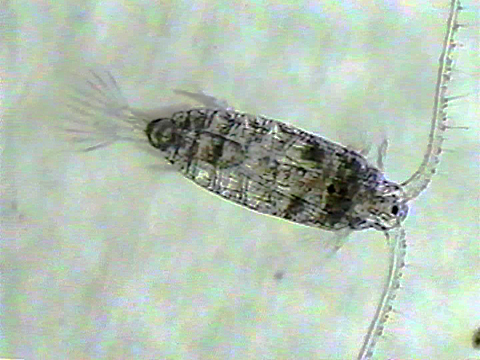LIFE UNDERWATER
- VEGETATION
- PLANKTON
- PHYTOPLANKTON
- ZOOPLANKTON
- BENTHOS
- FISH
- AMPHIBIANS AND REPTILES
PLANKTON - ZOOPLANKTON - BIODIVERSITY
![]() FLASH PLAYER IS REQUIRED TO SEE THE CONTENT OF THIS PAGE
FLASH PLAYER IS REQUIRED TO SEE THE CONTENT OF THIS PAGE

Zooplankton can be divided into four major taxonomic groups: protozoa, rotifers, cladocerans and copepods.
VIDEO - 0 min 7 s
Rotifers are microscopic organisms with a crown composed of two rows of cilia on their head (corona) that is used for locomotion and feeding.
This page contains videos that require Javascript and Adobe Flash Player to be activated. If you wish not to activate these functions, we offer pictures from the original videos.

VIDEO - 0 min 11 s
Cladocerans are microscopic crustaceans between 0.2 and 18 mm in size. They are generally no more than a few millimetres long. Their entire body, except the head, is enclosed in a two-valved carapace. The most well known cladoceran is the water flea (Daphnia).
This page contains videos that require Javascript and Adobe Flash Player to be activated. If you wish not to activate these functions, we offer pictures from the original videos.

VIDEO - 0 min 12 s
Cladocerans filter the water. They come in many different forms. Here, you can see a Holopedium gibberum.
This page contains videos that require Javascript and Adobe Flash Player to be activated. If you wish not to activate these functions, we offer pictures from the original videos.

VIDEO - 0 min 08 s
Copepods are also small crustaceans. They can measure between 0.5 and 5 mm, but are usually less than 2 mm. They make up the largest portion of the zooplankton. Calanoid copepods have long antennae.
This page contains videos that require Javascript and Adobe Flash Player to be activated. If you wish not to activate these functions, we offer pictures from the original videos.

VIDEO - 0 min 07 s
Copepods have several appendages (legs and antennae) bearing numerous bristles. These appendages are used as sensory organs (antennae), for locomotion and reproduction (legs and antennae) and to capture prey. Cyclopoid copepods have shorter antennae.
